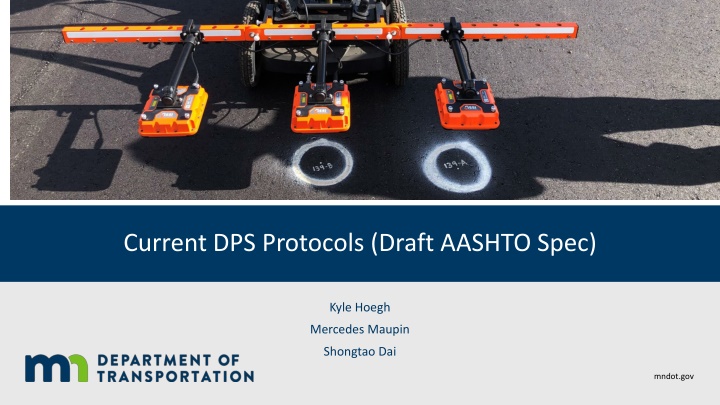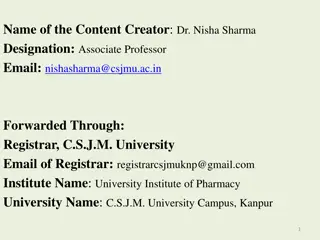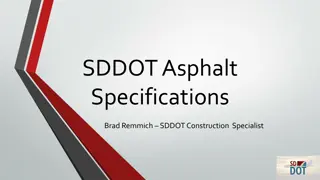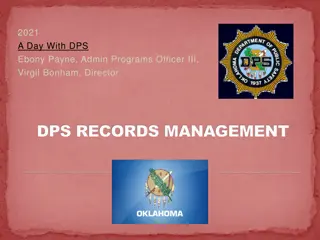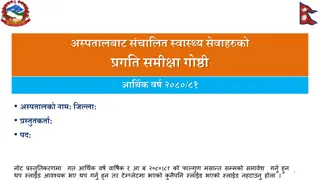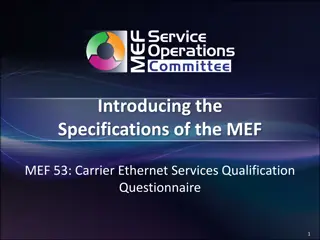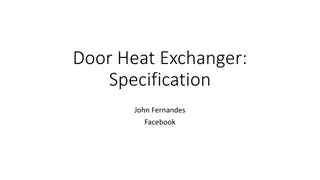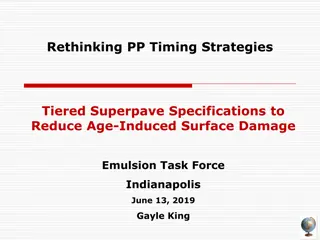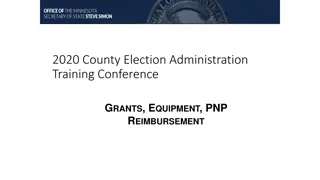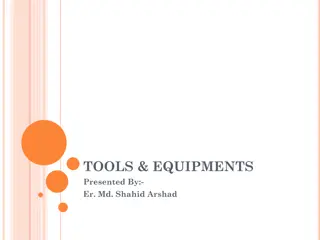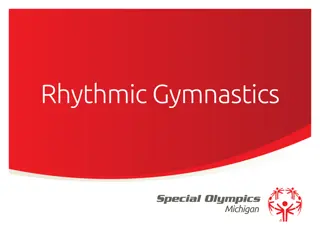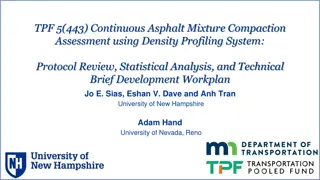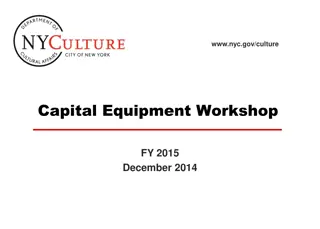Comprehensive Overview of Current DPS Equipment and Data Specifications
Detailed examination of the current DPS protocols and equipment specifications, including goals, challenges, and key focus areas. The draft AASHTO spec, dielectric calculation precision, data collection requirements, and deliverables are all covered. Emphasis on ensuring equipment accuracy and reliable data for density acceptance criteria. Minnesota's approach to joint and mat percent conformance is highlighted.
Download Presentation

Please find below an Image/Link to download the presentation.
The content on the website is provided AS IS for your information and personal use only. It may not be sold, licensed, or shared on other websites without obtaining consent from the author.If you encounter any issues during the download, it is possible that the publisher has removed the file from their server.
You are allowed to download the files provided on this website for personal or commercial use, subject to the condition that they are used lawfully. All files are the property of their respective owners.
The content on the website is provided AS IS for your information and personal use only. It may not be sold, licensed, or shared on other websites without obtaining consent from the author.
E N D
Presentation Transcript
Current DPS Protocols (Draft AASHTO Spec) Kyle Hoegh Mercedes Maupin Shongtao Dai mndot.gov
DPS Equipment Specification Goal: Specify type of equipment that has acceptable DPS surface reflection dielectric calculation precision/accuracy Challenge: Ensure correct equipment is used Doesn t specify necessary field use requirements 10/9/2024 mndot.gov 2
DPS Equipment Specification Draft AASHTO PP 98-19 specification is published Will be revisited so see if revision is necessary Plan to add similar equipment spec for velocity-based dielectric 10/9/2024 mndot.gov 3
DPS Data Specification Goal: Specify the type of data that needs to be collected by DPS in the field for use in Density Acceptance in the future Challenge: Ensure equipment is used correctly to obtain data that can be applied to agency specific density acceptance criteria Specifies protocols to obtain reliable density information, not a specific density acceptance criteria Minnesota considering joint and mat percent conformance over 100 ft. sublots Ensures acceptable data then gives flexibility to specific agencies to determine acceptance criteria 10/9/2024 mndot.gov 4
DPS Data Specification Draft data specification used for 2021 data collection by 2 Minnesota contractors Ensure sensors are consistent throughout day and project Ensure dielectric to density conversion is accurate for the full range of field densities and potential mix changes. Ensure routine collection used for acceptance evaluation is collected correctly and with necessary coverage Ensure necessary data is transferred in a timely manner 10/9/2024 mndot.gov 5
DPS Data Specification Deliverables Item A: Pre-paving Information so core locations can be pre-determined by the agency Item B: Projects folder containing all of the raw field data collection Item C: LabProjects folder containing all of the raw production mix puck information Software task currently underway to make cloud transfer of data more convenient 10/9/2024 mndot.gov 6
DPS Data Specification Compact Spec that References the Following for Details DPS Protocols - Chapter 2 - e to AV% Conversion DPS Protocols - Chapter 3 - DPS Pre- and Post-Paving Procedures DPS Protocols - Chapter 4 - Field e QA DPS Protocols - Chapter 5 - Field Routine Collection AASHTO specification draft Q1 of 2022 Data Specification updated Protocol Chapters updated Add an Analysis Protocol chapter Combine into a draft AASHTO Spec 10/9/2024 mndot.gov 7
DPS Data Specification 1. Pre-Paving Information Provide Agency with planned tonnage, start/stop stationing, and other information necessary to run random core location generator prior to paving. Provide this information to the agency before the beginning of paving each day. Estimate of the planned max density tonnage for the day Estimate of the planned stationing extents of the max density placed mat. 10/9/2024 mndot.gov 8
DPS Data Specification Project Setup 2. Field Data Description Provide Agency with necessary supporting information for field collected DPS dielectric data (much of this is streamlined in existing software to reduce manual data entry requirements of the user) 1. 2. 3. 4. 5. 6. 7. 8. 9. 10. Sensor ID 11. Sensor Lateral Offsets relative to reference line (centerline) 12. Station 13. Right Edge Type 14. Left Edge Type 15. GPS Position Project ID Route Designation Material Type County Date Paved Lift # Divided Highway Lane Extents Direction of Travel https://youtu.be/A3j870wC2dA?t=137 10/9/2024 mndot.gov 9
DPS Data Specification 3. Field Calibration Data Provide Agency with documentation of the results and timing of the most recent metal and air calibration applied when calculating the reported dielectric values (this is automatically tracked in existing DPS software). DPSP Chapter 3 Section 3.1.8 Metal value used for the full reflection amplitude Air value used as the signal response from air calibration mode, used to mitigate structural noise from each signal Both air and metal calibration recommended each time equipment is turned on, but only required to report most recent air and metal calibration. 10/9/2024 mndot.gov 10
DPS Data Specification 4. Field Dielectric Quality Check Data Provide Agency with dataset and corresponding documentation of periodic dielectric quality check datasets designed to allow the agency to evaluate the quality of the collected dielectric data. A. Conduct and evaluate a swerve or line test at the beginning of data collection each day to ensure system is working properly a. If either of the following criteria are met the test is successful and step A has been satisfied so and Step B is the only remaining field dielectric quality check data required for the day: i. all 3 sensors of either test are within 0.08 of the middle (by dielectric magnitude) sensor ii. all 3 sensors of both tests are within 0.10 of the middle (by dielectric magnitude) sensor b. Re-calibrate (detailed in item 3) and repeat if criteria not met c. Contact Agency for guidance if multiple recalibrations do not result in all sensors within specification limits (call or email Kyle Hoegh at 507-398-2669 or kyle.hoegh@state.mn.us) 10/9/2024 mndot.gov 11
DPS Data Specification 4. Field Dielectric Quality Check Data Provide Agency with dataset and corresponding documentation of periodic dielectric quality check datasets designed to allow the agency to evaluate the quality of the collected dielectric data. A. Conduct swerve test or line test throughout the day of testing to ensure data is continually in specification achieving each of the following minimum criteria: a. 1 test at least every 4000 ft of collected data b. 1 test at least every 4 hours 10/9/2024 mndot.gov 12
DPS Data Specification 5. Field Routine Dielectric Data Provide Agency with dataset designed to assess the overall mat and joint compaction level. All measurement passes shall be conducted with a 3 sensor arrangement at the vendor specified sensor height and 1.5 ft. spacing between sensors to allow for adequate coverage in a short amount of time. 10/9/2024 mndot.gov 13
DPS Data Specification 5. Field Routine Dielectric Data Provide Agency with dataset designed to assess the overall mat and joint compaction level. These sections are further categorized into centerline joint and mat categories. For centerline joint assessment, the contractor shall be conducting continuous (6 in. spacing) measurements with the adjacent sensor centered 6 in. (+/- 2 in.) offset collecting parallel to the joint movement (see DPSP Chapter 5 Section 5.1.1). A joint pass shall be considered fully executed if the centerline longitudinal joint has data collected at a 6 in. data density for a continuous 500 ft section. 10/9/2024 mndot.gov 14 https://youtu.be/FZQ2TRFJRVE?t=198
DPS Data Specification 5. Field Routine Dielectric Data Provide Agency with dataset designed to assess the overall mat and joint compaction level. These sections are further categorized into centerline joint and mat categories. For mat assessment, this shall be accomplished by conducting swerve passes (see DPSP Chapter 5 Section 5.1.2, and Chapter 4 Section 4.2.1), or two additional straight line passes (with middle sensor centered at 6 ft. and 10 ft from the centerline joint). 10/9/2024 mndot.gov 15
DPS Data Specification 5. Field Routine Dielectric Data Provide Agency with dataset designed to assess the overall mat and joint compaction level. While the goal is to have 100% complete sections as described above, the pay item increments are broken down in to 500 ft. sections to allow the contractor to focus on feasible to collect sections. Also, ability to conduct joint only collections are available in cases where only a single pass is feasible. Special requests for approval of less than the required percent complete can be made when extenuating circumstances occur that will be evaluated at the agency s discretion (contact Kyle Hoegh at MRR). Pay item increment: Provide cost per full-coverage 500 ft assessment ($/mat assessment and $/joint assessment) 10/9/2024 mndot.gov 16
DPS Data Specification 5. Field Routine Dielectric Data Provide Agency with dataset designed to assess the overall mat and joint compaction level. Successful mat pass is either: A swerve pass is collected with a data density of 6 inches traveling with the outer sensor traveling up to but no closer than 1 ft from the lane extent on both sides in both the paving direction and opposite the paving direction. Each swerve pass will be conducted individually. For example, a swerve test conducted between stationing 105+00 and 110+00 will collect starting at stationing 105 and ending at stationing 110 and starting at stationing 110 and ending at 105 since it is collected in both directions (As noted above, software is available to indicate that a swerve pass is being conducted to simplify this process). Straight passes at 2 ft, 3.5 ft, 4.5 ft., 6 ft., 7.5 ft, 8.5 ft, 10 ft., and 11.5 ft. from the centerline longitudinal joint 10/9/2024 mndot.gov 17
DPS Data Specification 6. Field Core Accuracy Check Data Provide Agency with dielectric measurements at agency-determined mat locations that will be cored and measured for air void content. These measurements are designed to assess the accuracy of the DPS air void assessment. 10/9/2024 mndot.gov 18
DPS Data Specification 6. Field Core Accuracy Check Data Provide Agency with dielectric measurements at agency-determined mat locations that will be cored and measured for air void content. These measurements are designed to assess the accuracy of the DPS air void assessment. Static measurement: Measurements taken with a single sensor directly over the center (+/- 1 in.) of the core location (note that DPS collection sensors are available that project a laser to the portion of the pavement that is centered below the sensor) o At least 200 dielectric measurements (ex. 5 seconds of data collection at a 40 hz rate) Distance measurement: Series of measurements taken with a single sensor spanning the longitudinal diameter of the core (DPS software exists that automatically performs this with the user specifying only when they start and end data collection) o At least 16 dielectric measurements will automatically be measured by rolling the device 6 inches when in this mode. https://youtu.be/f6yh2comdh4 o Specified both time and distance, but distance was more consistent. 10/9/2024 mndot.gov 19
DPS Data Specification 6. Field Core Accuracy Check Data Provide Agency with dielectric measurements at agency-determined mat locations that will be cored and measured for air void content. These measurements are designed to assess the accuracy of the DPS air void assessment. Specified 50% of total cores but logistics of core measurements proved difficult (more on this later) Importance of collecting data in proper conditions Allowed contractor to collect at core locations early morning due to logistical reasons Two rain event days. One faulty sensor. 10/9/2024 mndot.gov 20
DPS Data Specification 7. Field GPS Accuracy Check Data Provide Agency with static GPS coordinates from the DPS device at agency specified locations. Chose core locations since static measurements taken anyway with GPS Contractor passed but getting correct format of GPS string to output into DPS proved difficult One had to use our equipment. One got it to work with their equipment but had to use our equipment the first couple weeks as they were debugging. 10/9/2024 mndot.gov 21
DPS Data Specification 8. Laboratory Data Description Submit information corresponding to the laboratory collected dielectric data. https://youtu.be/lpVR3T1YrVY 10/9/2024 mndot.gov 22
DPS Data Specification 9. Laboratory Dielectric Data Submit dielectric measurements of laboratory compacted specimens fabricated at the range of air void contents specified. Air void range testing What 3 pucks (design void, medium, and high air void content) will be fabricated by the contractor following the procedures described in DPSP Chapter 2 section 2.1 Frequency One set of 3 pucks per day. The contractor can determine which 1000 tons ay Design void monitoring What quality control design void pucks for each sample will be tested for dielectric prior to for one sample per day of paving. Frequency The 60 second dielectric test should be conducted on the design void puck for every sample. Measurement of top, rotate 90 degrees, and bottom Later just top and bottom due to timing constraints and initial good agreement Consistent curve from day to day (especially low and medium voids) unless large change in mix. 10/9/2024 mndot.gov 23
DPS Data Specification Advantages over traditional way: Non-destructive Proven to detect changes in mix without cutting any cores in pavement Can ensure full range of air voids to develop conversion from dielectric to density More stable dielectric measurement than surface reflection field measurement: higher precision and covers entire thickness Easily integrated into the laboratory process Minimizes field operations disruption No additional staff (tech who gyrates pucks tests pucks for dielectric before dunking) Has potential value beyond DPS for monitoring mix property changes 10/9/2024 mndot.gov 24
DPS Data Specification 10. Timing requirements Collect data at the required timing after the final roller compactor pass and prior to trafficking and submit data within 4 days of data collection but ideally prior to paving the next day as defined in more details in item 10. Data collection timing and data transfer requirements vague to reduce contractor risk Ideal: Directly behind final roller with no visible surface moisture (only possible way on partial closures) Not preferred but allowed in the current specification: Following day data collection Addressed logistical challenges related to long time periods between paver and final roller Trouble with moisture after pavement has cooled (rain night before testing) 10/9/2024 mndot.gov 25
Contractor Debrief: Specification and DPS Method 1) Contractors want to know plans moving forward a.Would like to do pay for data by section to give incentive for contractors to figure out how to efficiently collect data (golf cart or other ideas) b.Research and Pavements need to meet internally to determine exact data specification we need i.Type of data we need for further research (mix sensitivity, sensor consistency checks, density accuracy checks, etc.) ii.Convenient for VETA (or whatever each state end analysis method is) iii.Logistically possible c.Once spec meets MnDOT internal criteria give specification to contractors i.Earlier this time so they have time to figure out how they ll accomplish the data collection needs/feasibility ii.Work with MnDOT or rental company to get necessary equipment to start building data collection method 10/9/2024 mndot.gov 26
Contractor Debrief: Specification and DPS Method 1)Routine collection challenges a.Same day collection behind the roller i.14 hours per day plus setup and putting equipment back ii.A lot of down time waiting for roller iii.If fully closed could wait until paver is about 3 hours from being done then have person come out with golf cart and get everything done in 6 hours iv.If partial closure this is a challenge b.Day after collection i.Issues with rain night before 10/9/2024 mndot.gov 27
Contractor Debrief: Specification and DPS Method 1) Core accuracy check challenges a. Day after paving isn t good i. rain night before, pavement in different condition, etc. ii.would need more of a hand held device b. Marking and testing cores while doing routine collection i. Use random cores using pre-paving information 1.Needed agency there to mark 2.Many adjustments made on the fly ii.Better to just add an extra 4 cores per day iii. Ideally just use DPS data with attached GPS coordinates to select core locations 1.Convenient for contractor (less work for them) 2.Would need to be extra cores 2022 construction season since too late to change how cores are selected for acceptance 3.Need to check accuracy: data collection is less precise than increased sampling at core locations 4.Maybe try this method to using 4 additional cores on a project or two next year 10/9/2024 mndot.gov 28
Contractor Debrief: Specification and DPS Method 1)Puck testing a.Going well, but would want to reduce number of fabricated pucks. b.Agency would be will be able to reduce but for time being still want to collect a lot of data to prove we don t need to in future (continue to show low sensitivity of day to day variability on dielectric to density relationship). 10/9/2024 mndot.gov 29
Contractor Debrief: Specification and DPS Method 1)Safety aspect is the most important factor a.Full closure was more comfortable for data collection than partial closure with moving traffic i.Would probably only do full closure in current state of technology https://youtu.be/FDPa4rpOclw https://youtu.be/k8ADpw6Rfsg 10/9/2024 mndot.gov 30
Contractor Debrief: Specification and DPS Method 1) Robot progress a. UMN still making progress on theirs, now reading in landXML alignments and doing offsets. b. Tiny Mobile Robots more promising i. Gave promising grid testing demonstration almost exactly like what we need on the LVR of MnROAD ii. Still need to make sure it can read in alignment files 1. Goal: Give start stop station, then robot automatically does full coverage as we define it in the data collection specification c. Contractor would see as right direction if final roller operator being able to start the robot in sections behind them, but need to consider live traffic possibly running into the robot https://youtu.be/tmg1dERSjk8?t=33 https://youtu.be/sXeXqpBNo04 10/9/2024 mndot.gov 31
Contractor Debrief: Specification and DPS Method 1)Equipment needs to be more rough and field testing proof (throwing in back of truck, etc.) a.Collected about 250 miles of data and one wheel was about ready to fall off b.Example of need: equipment arm broke i.Bad: took week to get it here ii.Good: just charged like $30 for part c.Another example of need i.GPS support took 2 weeks to figure out despite assurances it was ready for topcon 10/9/2024 mndot.gov 32
Contractor Debrief: Specification and DPS Method 1)Need better support a.Should be treated like pavement equipment not testing equipment if used for acceptance b.Suggested partnering with construction company similar to Caterpillar or Topcon 10/9/2024 mndot.gov 33
Contractor Debrief: Specification and DPS Method 1)Minimize exposure by minimizing passes a.Could probably still do 3 passes if golf cart mounted b.Extra sensors to do one pass 10/9/2024 mndot.gov 34
Contractor Debrief: Specification and DPS Method 1)Got rent to own option, but ended up not buying since the technology still seems green 2)Like the idea of anything that can minimize exposure and time on road a.Minimize passes i.More sensors ii.Maybe could still accomplish 3 passes if on a golf cart 10/9/2024 mndot.gov 35
Contractor Debrief: Specification and DPS Method 1)Technology has merit. He sees potential for Agency acceptance but still needs work as a contractor construction tool a.After final roller is too late b.If on intermediate rollers would be very helpful c.On construction app would be useful 10/9/2024 mndot.gov 36
Contractor Debrief: Specification and DPS Method 1)Suggested giving contractors incentive to build their own way of collecting data a.Paying by section rather than lump sum for project may accomplish this i.Contractors need enough experience to trust they can rely on properly functioning equipment and quick turnaround time to reduce risk of lost data/money 1.Would like to see more out of equipment ruggedness 2. Paver type company support not materials testing. 10/9/2024 mndot.gov 37
Contractor Debrief: Specification and DPS Method 1)From MnDOT Pavement Office point of view this type of feedback is exactly why we were pushing for rental trial a.Don t be shy or worrying about offending with collection ideas (Agencies want data, but not in business of making equipment so would prefer contractors to take ownership of how they d like to see equipment function) b.Don t be shy about giving negative feedback on necessary improvements 10/9/2024 mndot.gov 38
MnDOT Pavement Office Debriefing: Required Steps to Deployment Bituminous Unit: Review/modify DPS requirements to ensure "field" ready. Contractor/State staffing completing these activities are not always as detailed as our researchers. Review/modify special provision requirements to ensure compatible with our bituminous specifications (2360, 2365? And 2353?) Develop needed bituminous worksheets to be used in lab/field for DPS calibrations. Write special provision for density requirements with respect to DPS (e.g., price adjustment, for information purposes only, etc.) Hire additional staff to help support/review lab calibrations. Develop acceptance procedures to implement should DPS systems failures occur. 10/9/2024 mndot.gov 39
MnDOT Pavement Office Debriefing: Required Steps to Deployment Advanced Materials and Technology (AMT) Unit: Additional enhancements to Veta are still needed to successfully deploy the DPS technology. Develop Veta Training and Requirements. Review/modify special provision requirements to ensure data collection is compatible with Veta and other intelligent construction technology (ICT) (e.g., paver mounted thermal profiling, intelligent compaction, material delivery management system). Add needed language to special provision 2016 Quality Management Additional staff may be needed to support review of use of calibration curves within Veta and Veta project development. 10/9/2024 mndot.gov 40
MnDOT Pavement Office Debriefing: Required Steps to Deployment Bituminous and AMT Units Finalize repeatability / sensor review procedures to ensure "field" ready. Again, Contractor/State staffing completing these activities are not always as detailed as our researchers who do a great job and review the data during data collection and following procedures exactly. Finalize data collection procedures. Ensure all needed enhancements were made to Veta. Develop DPS data review worksheet using data generated by Veta. This is the procedure for review of Veta projects to ensure no human error or fraud has occurred during contractor creation of projects. Review/finalize independent verification procedures (CFR637) Review availability of equipment and vendor support (vendor training, available repair parts, repair turn around, vendor real-time field support). Review status of currently deployed new technologies (IC, PMTP, MDMS, etc.) and work with Contractors to determine best pilot schedule. Contractors have voiced concern about ensuring that deployment of new technologies is staggered and not all at once. (expenses, training, resources, sanity, etc.) Determine pilot project requirement level (shadow specification - for information purposes only?, price adjustments?, etc.). A deployment roadmap will be generated after the Bituminous and AMT units have piloted the technology on at least 6 projects outside of those done by the Research team. We will start out low risk (for information purposes only) during initial pilot projects implemented by the Pavement section to mitigate risk. Separate debriefing meetings will be held with contractors, district construction staff, and vendors. If pilot projects are not successful, the following questions will be addressed. o Special provision changes? o Dielectric statistical analyses requirement refinements? o Vendor changes? o Veta changes? If pilot projects are successful, we will then work with Contractors and Vendors to determine an appropriate deployment roadmap. Vendors are responsible for training, and real-time support and repair of DPS equipment. Department will assist with training and support of generation of calibration curves and development of Veta data mining procedures. Vendors will need some time to increase the number of systems and parts in stock and resources to support technology. They are currently used to the states providing training and support to the equipment and not having a real-time need for repairs. 10/9/2024 mndot.gov 41
UNH Review: Required technical improvements Coming up Now!!! 10/9/2024 mndot.gov 42
